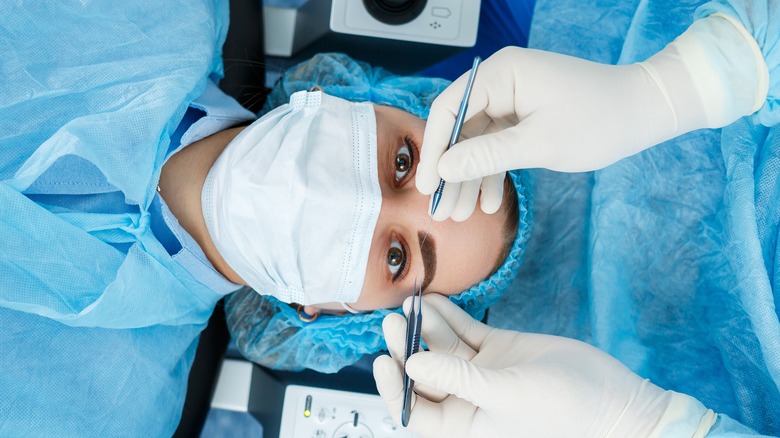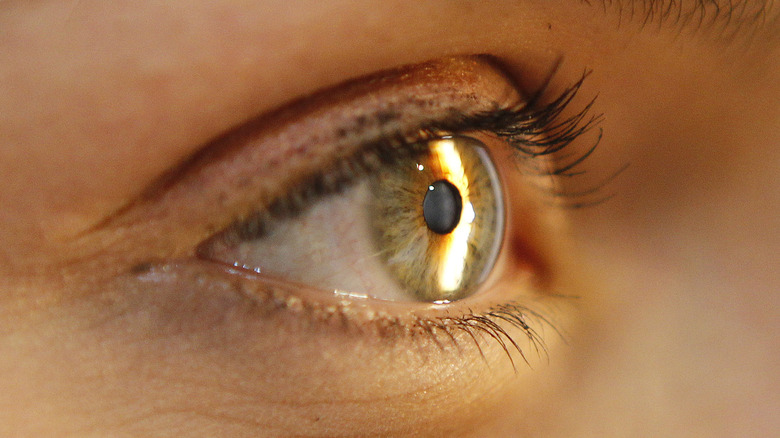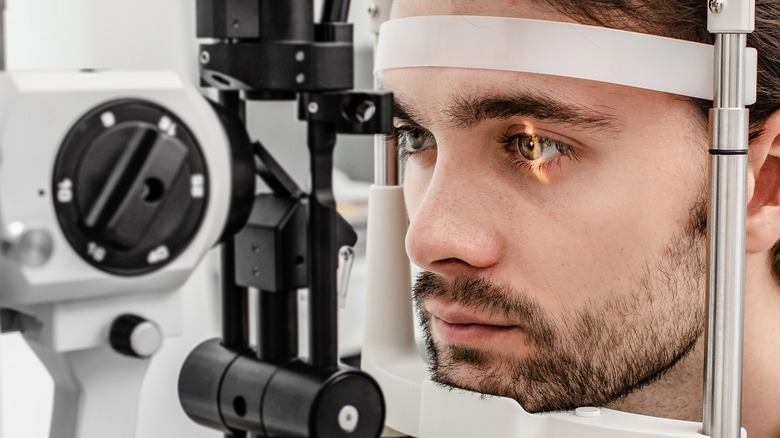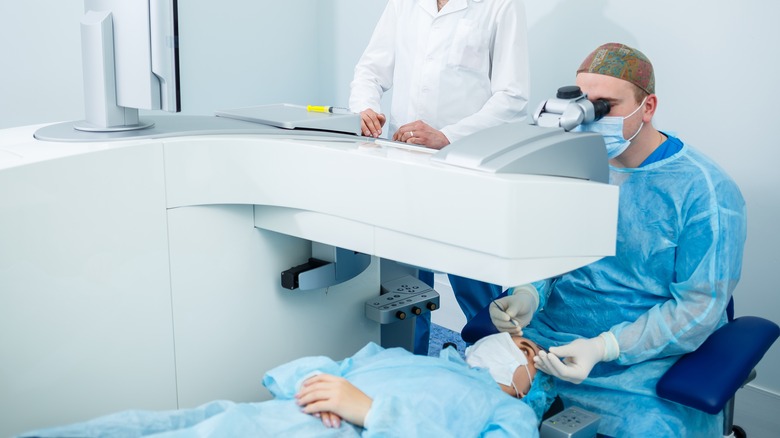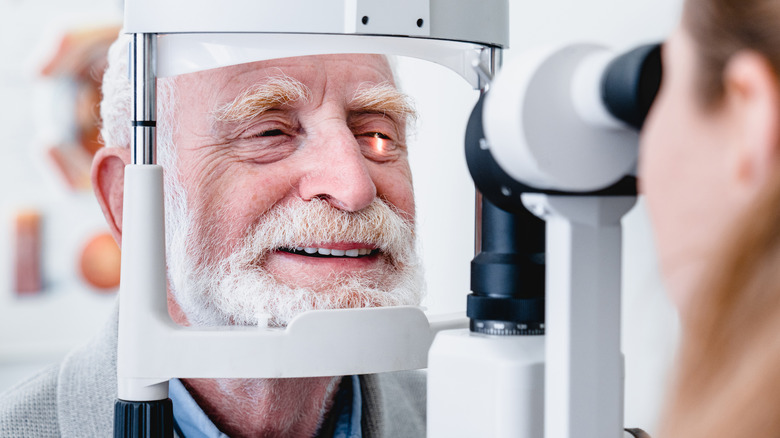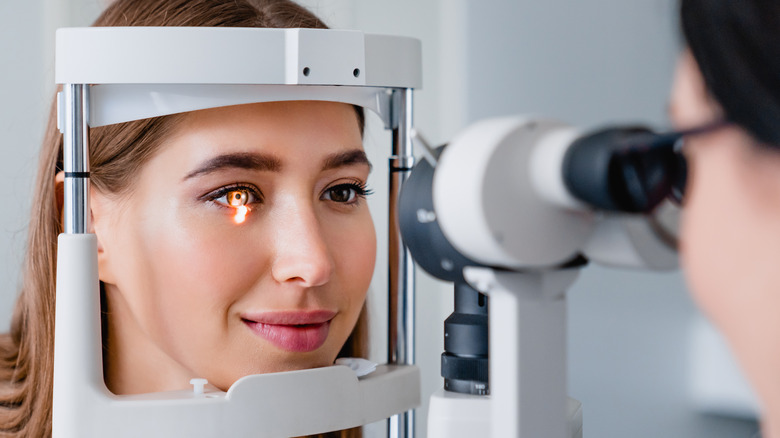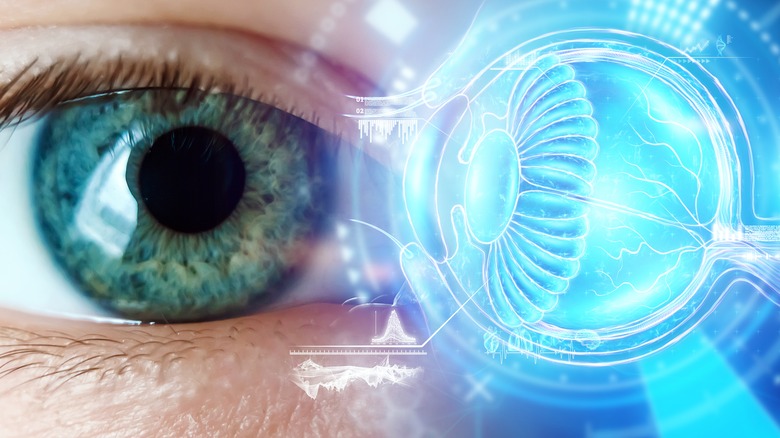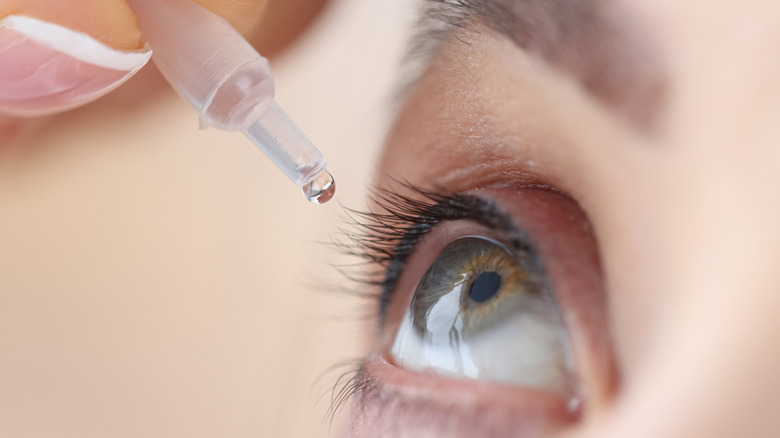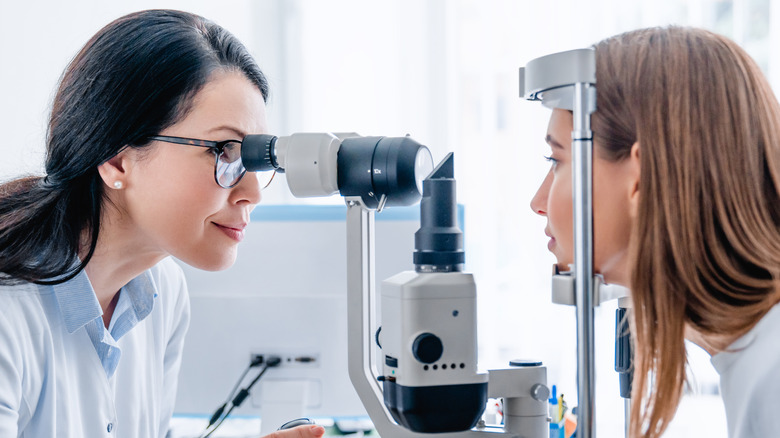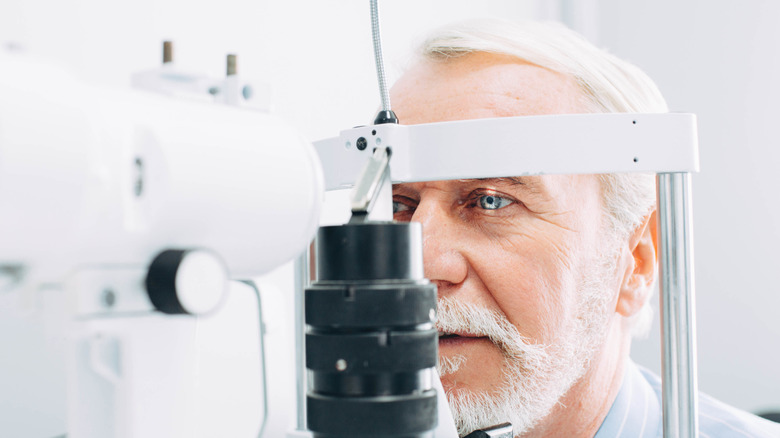Glaucoma Explained: Causes, Symptoms, And Treatments
According to the experts at Vision Source, the eye is a complex organ made up of delicate, intricate parts which work in sync in order for us to transfer the information we see to the brain and convert it into an image. The optic nerve is the only communication pathway we have — and once it's damaged, there is no known way to reverse it.
Defined as a group of complex eye diseases which damage the optic nerve, glaucoma is a serious condition that if left untreated, can lead to irreversible vision loss (via the Glaucoma Research Foundation). In fact, glaucoma is the second on the list of the most common causes of blindness, per the Centers for Disease Control and Prevention (CDC).
There are different types of glaucoma, and while some groups of people are at a higher risk of developing this disease, anyone can start experiencing symptoms as they age. The danger with glaucoma lies in its gradual progression, often with no warning signs and a slow process of development that doesn't produce noticeable changes in vision before it's already too late. Here's everything you need to know about glaucoma, including its causes, symptoms, and treatment.
Types of glaucoma
There are many different types of glaucoma, and they differ in causes, symptoms, signs, and stages of development. Open-angle glaucoma is said to be the most common type of glaucoma (via Healthline). It's caused by a rise of the intraocular pressure (IOP) that occurs when the eye canals become clogged and the fluid accumulating in the eye cannot be drained out. Since the clogging occurs deep inside the drainage canals, most people affected by this type of glaucoma experience no early symptoms or warning signs. Thus, even though it responds well to treatment and medications when detected promptly, it can cause irreversible damage if not dealt with early on.
Normal-tension glaucoma is a type of glaucoma that isn't followed by high IOP (via StatPearls). In fact, it mostly stays in the low range. Researchers mostly consider it to be a version of open-angle glaucoma, but the pathogenesis still remains unclear, leaving room for debate and controversy. Still, there are some characteristics of normal-tension glaucoma that make it stand out. These include migraines, low blood pressure, hemorrhages in the blood vessels of the optic nerve, and visual field disorders that occur closer to the center of the vision.
Angle-closure glaucoma or closed-angle glaucoma happens when the trabecular meshwork sustains damage or is obstructed, resulting in fluid backup that causes a rise in IOP (per Healthline). Angle-closure glaucoma may either be acute (when it happens quickly, which is more common) or chronic (when it develops over time).
Secondary glaucoma
Secondary glaucoma is caused by another medical condition or disease that affects the intraocular pressure and results in optic nerve damage (per the Glaucoma Research Foundation). Most of the other types of glaucoma are considered to be variants of either open-angle glaucoma or angle-closure glaucoma, and they can affect both or only one eye.
Exfoliative glaucoma is characterized by a build-up of flaky material that peels off the outer layer of the eye lens, causing the blockage of the drainage canals. Meanwhile, pigmentary glaucoma is developed when the pigment granules at the back of the iris break into the eye fluid and clog the drainage canals. Neovascular glaucoma is caused when new blood vessels form over the eye's drainage canals and the iris, causing blockage.
Traumatic glaucoma happens after an injury that either penetrates the eye or bruises it. Uveitic glaucoma involves the swelling of the eye's middle layer (uvea). Last but not least, an infant may suffer from congenital glaucoma as a result of abnormal development of the eye drainage system prior to the child's birth.
Causes of glaucoma
The causes of glaucoma vary depending on the type, but except for the normal-tension glaucoma, it's almost always a result of an increase in eye pressure due to the blockage of eye drainage canals. This can occur due to an illness, injury, inflammation, tumors, certain drugs and medications, dilating eye drops, high blood pressure, diabetes, autoimmune diseases, an advanced stage of cataracts, or even genetics, as in most cases it can be hereditary.
The rise in the intraocular pressure damages the optic nerve and causes a gradual sight loss, potentially leading to blindness. However, in the case of normal-range glaucoma, the IOP is normal, but the damage still occurs. Currently, there is no known cause of normal-tension glaucoma, but experts believe that the factors contributing to its development include structural weakness of the optic nerve tissue and specific abnormalities in the blood flow to the optic nerve.
Risk factors for developing glaucoma
Even though everyone can be diagnosed with glaucoma in their lifetime and the exact causes of glaucoma aren't completely clear, there are certain groups of people and factors which can make them at higher risk of developing this complex disease (via John Hopkins Medicine). People over 60 years of age are the most likely group to develop glaucoma. It's 6 to 8 times more likely to occur in African Americans than white Americans (per the CDC). Meanwhile, findings from a paper in Opthalmology show that Asians are more likely to experience angle-closure glaucoma. Moreover, people with thinner corneas are also at higher risk of developing glaucoma.
Research published in Archives of Opthalmology shows that family history may play a role in one's risk of developing open-angle glaucoma, which may be hereditary. Therefore, having a family member diagnosed with glaucoma puts you at a greater risk of developing it yourself. Eye injury or trauma which cause bruises and injuries penetrating the eye can damage the eye drainage system. This can occur immediately after the injury or even several years later. Additionally, a paper published by StatPearls establishes a connection between steroid use and glaucoma development.
Symptoms of glaucoma
As the experts at Health One Family Medicine explain, there are typically no early symptoms or warning signs of glaucoma, and by the time you start experiencing vision loss, it's already irreversible. The only real way you can offset vision loss is by performing regular eye exams, especially if you fall under any of the categories of people at an increased risk of glaucoma.
That said, there are certain symptoms you should pay attention to, in order to prevent the condition from becoming too serious. Be wary of hazy eyes and blurred vision, severe and sudden eye pain (sometimes accompanied by nausea and vomiting), sudden, inexplicable migraines, increased sensitivity to light, seeing halos or rainbow-colored circles around bright lights, and sudden sight loss (or a blind spot in your field of vision).
Unfortunately, these symptoms occur gradually. In most cases, they don't even present themselves before it's too late. In the case of acute angle-closure glaucoma, the symptoms are noticeable and sudden, but so is the progression of the disease which makes treatment and possible healing very unlikely (via StatPearls).
Glaucoma diagnosis
Glaucoma is usually diagnosed through a regular eye exam, which is recommended for those at an increased risk of developing this disease.
The Glaucoma Research Foundation thoroughly explains the procedure for a regular eye exam, which consists of five common tests that can detect glaucoma. Tonometry is a test that measures the intraocular pressure using a device called a tonometer. The normal eye pressure falls within the 12-22 mm Hg (millimeters of mercury) range, so when the test result exceeds it, it's usually a sign of glaucoma. However, in the case of normal-tension glaucoma, the eye pressure does not exceed the optimal range.
Ophthalmoscopy is a diagnostic procedure that checks for optic nerve damage. If there are abnormalities in the way your optic nerve looks (especially if it's accompanied by high IOP), more tests will be required. Meanwhile, perimetry analyzes your complete field of vision and checks for any blind spots or light delays. Gonioscopy is a test that helps detect whether the angle between the cornea and the iris is wide and open or closed and blocked, while pachymetry is a diagnostic procedure that measures your corneal thickness.
Understanding intraocular pressure
Also called eye pressure, intraocular pressure (IOP) is the measurement of the fluid pressure in the eye (via StatPearls). Per the American Academy of Ophthalmology (AAO), there are two types of fluids surrounding the eye: the jelly-like vitreous humor and the transparent, watery aqueous humor. Aqueous humor mostly fills out the front of the eye, helping it stay inflated and nourished. Since the eye constantly produces this liquid, there are drainage canals through which it must be flushed out. The liquid flows at an angle in front of the cornea and iris, and when something obstructs the flow and blocks and restricts these canals, it causes the intraocular pressure to rise.
IOP is measured in millimeters of mercury or mm Hg, with a healthy range between 12 and 22 mm Hg (per the Glaucoma Research Foundation). When your IOP falls under or goes over this range, it can cause damage to the optic nerve and sight loss. A simply elevated IOP is defined as ocular hypertension, and it's one of the main symptoms of glaucoma (via AAO).
Care and treatment for glaucoma
The most common treatments for glaucoma include medications and surgery. Medications are supposed to help drain the liquid from your eyes (via the Glaucoma Research Foundation), thus reducing the eye pressure and preventing the optic nerve damage. These medications are usually in the form of eye drops or pills, but they come with a myriad of potential side effects. As a result, your doctor may prescribe a specific combination of medications (or even switch them up throughout your therapy) in order to address the side effects.
Surgery, on the other hand, is the more invasive option, and it's used when the medications simply aren't effective. There are two main types of glaucoma surgery, selective laser trabeculoplasty or SLT (via the Journal of Current Glaucoma Practice) and incisional surgery. SLT is a laser treatment that helps improve eye fluid drainage due to chemical and biological changes in the laser-affected tissue. Meanwhile, incisional surgery is typically the last option when it comes to treating glaucoma, recommended when neither medications nor laser treatments suffice. During the procedure, a tiny hole is made in the sclera (the white part of the eye), basically creating a new drainage canal through which the fluid can flow without restriction (per the Glaucoma Research Foundation).
New and alternative treatments for glaucoma
Ophthalmology Times reports that in addition to existing medications and surgery, experts are finding new and alternative treatments for glaucoma that are yielding promising results. These include new forms of medications and micro-invasive glaucoma surgery options, which are safer and produce fewer side effects. Furthermore, there are other, non-medical alternative treatment options that are raising interest in many people.
A review published in Current Opinion in Ophthalmology explores the potential role of the herbal supplement ginko biloba in the treatment of glaucoma. It's believed that its high antioxidant and vascular effects decrease inflammation and increase ocular blood flow in those with glaucoma. On the other hand, medical marijuana is known to lower intraocular pressure (via the National Academy of Sciences), which was one of the reasons for legalizing medical marijuana in the first place.
The Glaucoma Research Foundation cites a small-scale study in India that shows a significant decrease in IOP through mindfulness meditation. Since stress boosts cortisol production (which can increase eye pressure), reducing stress levels can help decrease eye pressure as well.
Glaucoma prevention
Since signs of glaucoma aren't usually detected before the damage is irreversible, prevention is key. It's wise to have regular eye exams, because seeing your ophthalmologist consistently is one of the most important tips to prevent glaucoma and nerve damage, especially if you're at a higher risk of developing glaucoma (via the Glaucoma Research Foundation). That way, your doctor will be able to detect early signs and start you on a treatment plan that can help prevent any further damage or complications.
Additionally, be careful when it comes to steroid medications, as they're known to increase IOP. Talk to your doctor about performing regular eye exams while you're on steroid medications. It's also important to implement healthy lifestyle habits: a nutritious diet, regular exercise, adequate sleep, and stress-reducing techniques. These will all help reduce inflammation in your body and improve your health in general. Keeping your blood pressure, cholesterol, and blood sugar at normal levels will also help prevent a plethora of diseases that you may become increasingly at risk of developing as you age.
Lastly, do your best to protect your eyes from trauma and injury — and when you notice any possible signs of irregularities in your eyes, have your ophthalmologist run diagnostic tests as soon as possible.
Glaucoma and nutrition
The role of diet and nutrition in glaucoma prevention shouldn't be ignored. A 2012 study in the American Journal of Ophthalmology shows a possible link between "decreased likelihood of glaucoma in older African-American women" and consuming more fruits and vegetables rich in caratenoids, vitamin A, and vitamin C. On the other hand, 2001 research published in the Journal of Glaucoma also shows caffeine consumption possibly having the opposite effect.
When trying to treat or prevent health problems, cleaning up your diet is one of the main things you can control, so it comes as no surprise that it's a general recommendation for everyone. According to the Harvard School of Public Health, choosing whole, unprocessed foods may help support your immune system and reduce inflammation. Stay away from ultra-processed and sugary foods, and fill your plate with micronutrient-rich fruits and vegetables, as well as fiber-rich foods. You may also fill in any nutritional gaps with supplements, though you should still prioritize having a "good-quality diet."
Glaucoma and sleep
Another important lifestyle habit you should focus on is sleep. Sleep is extremely important when it comes to your overall health and longevity, helping your body recover and successfully complete all repair processes. Unfortunately, according to the experts at Sleep Health, 50 to 70 million Americans are experiencing sleep-related problems, resulting in insufficient or poor-quality sleep. A lack of good sleep is one of the major factors that contribute to the development of obesity, diabetes, and other metabolic diseases.
Meanwhile, a 2019 study cited by Healio affirmed that sleep duration and latency also matter. According to the study, when compared to participants who slept an average of seven hours per night, those who slept for 10 hours or more were three times more likely to be diagnosed with disc-defined glaucoma. Although long sleep time and daytime fatigue aren't surefire symptoms of glaucoma, it's important to discuss your sleep and sleep quality with your ophthalmologist.
Glaucoma and COVID-19
With the COVID-19 pandemic affecting the global healthcare system, there are many studies examining how the virus could have impacted other diseases and disorders. A paper published in Nature discusses how the pandemic caused increased anxiety and concern about receiving medical care and scheduling regular check-ups, potentially worsening the cases of glaucoma overall.
One of the main ways of preventing glaucoma is through regular check-ups, so if these become less frequent due to the fear of getting infected with COVID-19, a person's chances of developing glaucoma would increase. This is especially the case for people who are already at a higher risk for developing glaucoma in the first place, as many are exhibiting uncertainty about going out for eye exams and proper care.
That said, this particular effect of COVID-19 has been observed throughout the entire medical system (per News Medical). It's not farfetched to expect that cases of glaucoma, cancer, and other diseases would increase dramatically in the coming years.
Potential new strategies in treating glaucoma
Along with the evolution of medicine, many existing procedures for diagnosis and treatment have improved over the years. There has also been an increase in potential new options for treating serious diseases, and while many of them are still in the experimental phase, they've managed to show promising results.
For instance, experts at the Glaucoma Research Foundation have talked about retinal ganglion cell replacement, which uses stem cell therapy to regenerate sick cells and replace the ones that have already been lost. While much research still has to be conducted on this type of treatment, it does have noteworthy potential in terms of protecting or perhaps even restoring vision in patients with glaucoma.
Meanwhile, the National Institutes of Health has funded research on gene therapy, exploring its potential to protect optic nerve cells and prevent vision loss. Tests have so far only been conducted on mice, though.

